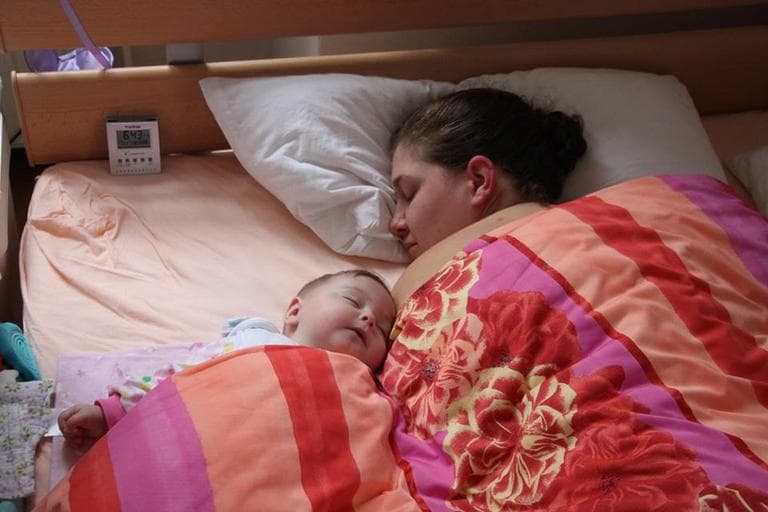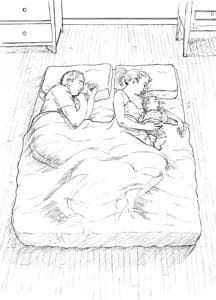Advertisement
Co-Sleeping Controversy, And Tips For Making Bedsharing Safer
 By Sarah Kerrigan
By Sarah KerriganGuest Contributor
Over the last week, my post on co-sleeping and public policy has generated a huge, passionate response.
Comments ranged from heartfelt, personal stories of family bedsharing to adamant opposition to the practice, from questions about terminology to pleas for more information about safe bedsharing.
Riobound wrote: “I like the idea of ‘educate’ but don't ‘dictate.’ The State should inform not impose.”
And PilgrimOnTheJames posted that “we shared our bed with each of our seven babies…for the first several months of their post-partum lives…because it allowed my wife to breast-feed them without her having to greatly disturb her much needed rest, and also, because the little tikes smelled so good and were so cute to watch sleeping. We moved them into a separate bed in our room once they were able to consistently sleep through the night. The bonds that were begun then have only grown and strengthened over the past 30+ years of family life. I thank God that we ignored the advice of many well-meaning, but totally scandalized family members and friends.”
Amelia Oliver commented, “Thank goodness the scientific community is finally considering moving away from trying to scare people out of bed-sharing and co-sleeping. The comparison with the policy of advocating abstinence instead of sex-ed is strikingly appropriate since almost everyone does it but we are all afraid to talk about it, let's start teaching the safe way to do it.”
Molly pointed out “This article…conflates the issues of cosleeping in bed sharing, which are not the same thing. Cosleeping is risk free, end of story. Bed sharing does have risks if not done carefully and correctly.”
So in an effort to shed more light on the topic, I'll try here to clarify the terms, explain why the research linking SIDS to bedsharing is inherently flawed, and provide some tips to make sleep as safe as possible for all babies.
1. Terminology
In the scientific community, “co-sleeping” is a general term for a child sleeping in close proximity to a caregiver, within sensory range. “Room-sharing” is when a child sleeps in the same room as her caregiver. Under this definition are two sub-categories: “separate-surface cosleeping,” in which the child has his own bed, and “same-surface cosleeping,” also known as bedsharing. “Bedsharing” is the term that describes what most Americans think of when they hear “co-sleeping:” a child sleeping in an adult bed with his caregivers. This sort of close proximity is natural to the human species.
But many researchers, medical professionals and worldwide organizations question the AAP's position on bedsharing, in large part due to 'shaky evidence' as the basis of the academy's position, and also given the benefits of the practice. Dr. Abraham Bergman, a prominent SIDS researcher and pediatrician said in an email that “the evidence linking bed sharing per se to the increased risk for infant death is shaky, and certainly insufficient to condemn a widespread cultural practice that has its own benefits.” The WHO, UNICEF, La Leche League International, the Breast Feeding section of the AAP, and Academy of Breast Feeding Medicine all disagree with a sweeping recommendation to avoid bedsharing.
In an editorial published earlier this month in JAMA Pediatrics called “Bedsharing per se Is Not Dangerous” Bergman wrote:
it is becoming clear to many doctors and researchers that “non-uniform and unverifiable information on the causes of death” in SIDS studies led to conclusions about bedsharing that are not supported.
Death reports are recorded by county officials, and in the United States there are over 3000 counties. Each county has a different form and methods of collecting death information. There is no standardization, and cultural and personal biases can play a role in death reports. The major concern is with over 3000 officials using their own judgment to decide cause of death, rather than a standardized reporting system that looks at all SIDS risk factors. So when an infant dies in an adult bed it would be common for the bed itself and the sharing of space with an adult to be cited as the cause of death. In many cases, the death of a baby while sleeping with an adult on a couch or lounge chair (both dangerous sleep situations with a high risk of entrapment and suffocation) would be classified as a death due to bedsharing as well: this adds to the supposed “data” against bedsharing.
A UNICEF statement on bedsharing concurs: “There is robust evidence that sleeping with a baby on a sofa or armchair dramatically increases the risk of Sudden Infant Death Syndrome (SIDS), as does sleeping with a baby when under the influence of alcohol or drugs or when parents smoke. However, there is little evidence or expert consensus as to whether there is any risk to bed-sharing in the absence of known risk factors.”
We now know that a baby in a crib in a room alone is actually at higher risk of SIDS than a baby sleeping in the same room as a caregiver. Since proximity is a protective factor against SIDS, I would argue that bedsharing, when practiced absent of other risk factors, can be a very safe sleep environment for many babies.
I am not attempting to encourage families to share a bed with their infants. But I believe that each family has the intrinsic right to be informed of their choices, and to arrange the safest possible sleep situations for their babies. While the AAP advises against bedsharing, it does recommend room-sharing for all babies under the age of one.
3. Safe Sleep for Babies
A healthy gestation is the first step in reducing the risk of SIDS. Exposure to smoke while in utero, being born prematurely or at a low birth weight, and lack of prenatal care are all established risk factors.

•Breastfeeding significantly reduces the risk of SIDS for all babies
•Babies should be dressed lightly for sleep, and their heads should not be covered.
•It is not safe for infants to sleep on sheepskins, bean bag mattresses, water beds, couches or sofas. The risk of smothering or entrapment is high in such situations.
4. More Tips For Safer Bedsharing
•Consider using an attached co-sleeper bassinette as an extension of your bed surface. This is an excellent option that provides the closeness of bedsharing but also meets the AAP’s recommendation for a separate sleep surface for your baby.
•Infants under age one should not bedshare with older children. If there is more than one adult in the bed, both should share responsibility for the baby’s safety and well-being at night.
•Never sleep with your baby on a couch or waterbed. The risk of entrapment and suffocation is very high in these situations.
•If an adult is using any prescription medication that may increase drowsiness, or using drugs or alcohol, bedsharing is not a safe choice.
•Babies should always be placed to sleep on their backs, on a firm, clean sleep surface, with no pillows, blankets or stuffed animals nearby.
•To reduce the chance of entrapment or falls, the adult mattress should be placed on the floor, away from walls where a baby could become wedged
•Babies who sleep close to their parents have better temperature regulation, breathing patterns and heart rhythms than babies who sleep alone.
•Proximity during sleep promotes breastfeeding and reduces the risk of SIDS.
•Babies who bedshare startle less during the night, and can spend less time crying.
•Some studies show long-term emotional health benefits to bedsharing
Readers, parents, have we missed anything here? Let us know.
Sarah Kerrigan, M.A. is a Child Development Specialist, trained pediatric sleep consultant, and the mother of two young children.
This program aired on November 15, 2013. The audio for this program is not available.
